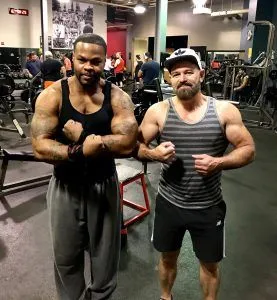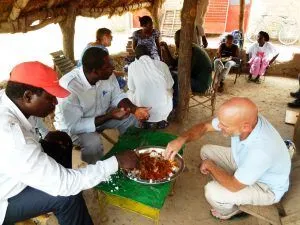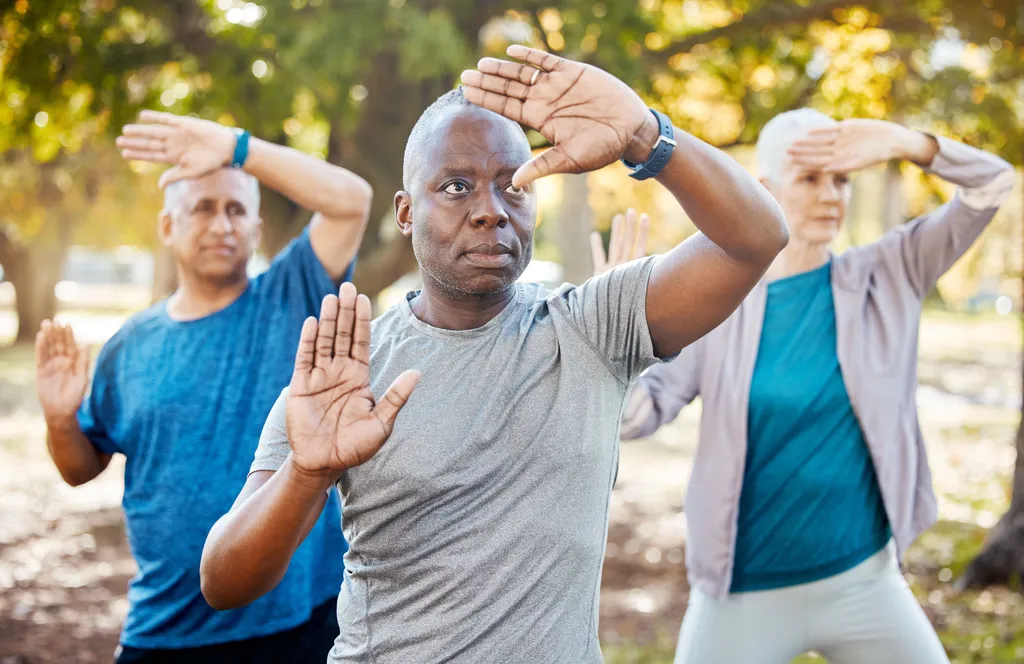Paul Butler: Making Exercise a Priority as a Myeloma Patient

During the month of September, we will be featuring stories and articles about fitness and multiple myeloma as part of our Muscles for Myeloma series.
As written by Paul Butler, 59 year old myeloma patient.
When I was first diagnosed with multiple myeloma, in October 2013, the news was grim: the bone marrow biopsy showed that nearly 80% of my bone marrow was cancerous, I also had amyloidosis. There were lytic lesions in my skull, left humerus, and in both femurs. My Lambda light chains were at 1,880 mg/L (normal is between 5.7 and 26.3). I was beyond exhausted, always out of breath, and the good muscle tone I formerly had from regular exercise had shriveled away; down to 130 pounds, I looked like a skeleton. Eating was difficult. I wasn’t even sure I would live, much less be able to exercise ever again.
“I know you probably don’t feel like moving, but it’s important to get some exercise everyday.”
I was listening to an oncology nurse who was giving me the low-down on my new life as a cancer patient. I was to begin chemotherapy the next day. Up until then, I had been mostly lying on the couch, sometimes searching the internet, trying to find out what it was like to die from this disease. I never did find much information about that! Lucky for me, my military son was on deployment in Guam and had left his two dogs with us. My wife had to soldier on each day at her job with the State of Maryland, which provides our health insurance. So it was up to me to get up and walk the dogs, a big husky puppy and a scrappy little poodle - and that was my first exercise routine as a cancer patient. At first, I couldn’t even cover half a mile, but just the act of getting up, getting outside and exerting myself even a little, made me feel better - both physically and mentally.
With chemotherapy (16 weeks of Cytoxan-Velcade-Dexamethasone), and lots of prayer from friends and family, I began to rapidly recover. I really began to look forward to those walks, picking up the pace and increasing the distance. (I’m usually in West Africa during the fall months, so it was a bonus to be able to enjoy crisp air and fall colors)! Halfway through the 16 weeks, I was finally regaining weight (the dex gave me a ferocious appetite!) so I decided to try some simple body-weight exercises at home: push-ups, crunches, and squats. Now that it appeared I was going to live, I also wanted to regain some strength. A month further on, I rejoined my local gym and began slowly, steadily to resume weight-training.
Exercise has been and continues to be to be a vital help in this journey because:
-
It is something simple and practical that I can do to improve my well-being. It makes me an active participant in the battle against this disease and reminds me that I am not just a victim of circumstances. There are things I can DO!
-
There is the immediate payoff of a lift in my mood that comes from good old-fashioned exertion. It’s a great way to de-stress! And there is the long term benefit of better overall health. Exercise is a forward-looking, hopeful thing!
-
I believe that the more I can improve my overall health through exercise, the better able I will be to tolerate future treatments and bounce back.
As far as exercise activities, weight training/lifting is what I enjoy most. It’s a proven fact that resistance training builds bone mass, and given this disease, that’s pretty important to me! I also incorporate plenty of body weight and flexibility exercises like pull-ups and push-ups, squats and lunges and various stretches. For cardio, I walk the dogs. My wife is a marathon runner, and she challenges me in the cardio department!
There have certainly been times, and there still are, when I am really tired from maintenance chemotherapy, and other times that travel makes it hard to keep to a routine. If fatigue is the issue, I still try to push myself to do something, even if I don’t make it through a whole routine, I just modify. I figure something is better than nothing at all. And then I try to go to bed early. If it’s schedule or travel, I try to at least do some body weight exercises wherever I am. It’s still really challenging when I am in a rural village in West Africa for a month or two. There’s no gym, and it’s really hot, so if I don’t do something early in the morning, it’s not going to happen. I’m hoping to do better in the exercise department next time I am there!
Advice for other myeloma patients struggling with exercise:
First of all, be kind to yourself, but that also includes challenging yourself to do better if you possibly can. Approach exercise as self care rather than an unpleasant chore - you’re doing something good for yourself! Start slowly and build up gradually. Move everyday if at all possible.
Figure out what works best with your treatment schedule. Last year, I did another 24 weeks of IV chemo, every Wednesday. I knew I would be hyper from the dexamethasone and probably unable to sleep much. So I would go to the gym at 10pm and put all that chemical energy to good use! Now, I take Ninlaro every other Wednesday. I know that by Thursday sometime I’m going to be tired and I’ll probably have mild stomach cramps. So I try to hit the gym the same day I take the pill, before the fatigue and discomfort set in.
For me, exercise is all part of cooperating with the healing/treatment process. The medical professionals can’t do that part for us. It’s one of the ways we get to actively participate in our progress and help things along. I do see life - every single breath - as a gift. I believe we have a responsibility to steward that gift and to do what we can to keep our bodies in good working order if at all possible.
Thanks to our Muscles for Myeloma sponsor
During the month of September, we will be featuring stories and articles about fitness and multiple myeloma as part of our Muscles for Myeloma series.
As written by Paul Butler, 59 year old myeloma patient.
When I was first diagnosed with multiple myeloma, in October 2013, the news was grim: the bone marrow biopsy showed that nearly 80% of my bone marrow was cancerous, I also had amyloidosis. There were lytic lesions in my skull, left humerus, and in both femurs. My Lambda light chains were at 1,880 mg/L (normal is between 5.7 and 26.3). I was beyond exhausted, always out of breath, and the good muscle tone I formerly had from regular exercise had shriveled away; down to 130 pounds, I looked like a skeleton. Eating was difficult. I wasn’t even sure I would live, much less be able to exercise ever again.
“I know you probably don’t feel like moving, but it’s important to get some exercise everyday.”
I was listening to an oncology nurse who was giving me the low-down on my new life as a cancer patient. I was to begin chemotherapy the next day. Up until then, I had been mostly lying on the couch, sometimes searching the internet, trying to find out what it was like to die from this disease. I never did find much information about that! Lucky for me, my military son was on deployment in Guam and had left his two dogs with us. My wife had to soldier on each day at her job with the State of Maryland, which provides our health insurance. So it was up to me to get up and walk the dogs, a big husky puppy and a scrappy little poodle - and that was my first exercise routine as a cancer patient. At first, I couldn’t even cover half a mile, but just the act of getting up, getting outside and exerting myself even a little, made me feel better - both physically and mentally.
With chemotherapy (16 weeks of Cytoxan-Velcade-Dexamethasone), and lots of prayer from friends and family, I began to rapidly recover. I really began to look forward to those walks, picking up the pace and increasing the distance. (I’m usually in West Africa during the fall months, so it was a bonus to be able to enjoy crisp air and fall colors)! Halfway through the 16 weeks, I was finally regaining weight (the dex gave me a ferocious appetite!) so I decided to try some simple body-weight exercises at home: push-ups, crunches, and squats. Now that it appeared I was going to live, I also wanted to regain some strength. A month further on, I rejoined my local gym and began slowly, steadily to resume weight-training.
Exercise has been and continues to be to be a vital help in this journey because:
-
It is something simple and practical that I can do to improve my well-being. It makes me an active participant in the battle against this disease and reminds me that I am not just a victim of circumstances. There are things I can DO!
-
There is the immediate payoff of a lift in my mood that comes from good old-fashioned exertion. It’s a great way to de-stress! And there is the long term benefit of better overall health. Exercise is a forward-looking, hopeful thing!
-
I believe that the more I can improve my overall health through exercise, the better able I will be to tolerate future treatments and bounce back.
As far as exercise activities, weight training/lifting is what I enjoy most. It’s a proven fact that resistance training builds bone mass, and given this disease, that’s pretty important to me! I also incorporate plenty of body weight and flexibility exercises like pull-ups and push-ups, squats and lunges and various stretches. For cardio, I walk the dogs. My wife is a marathon runner, and she challenges me in the cardio department!
There have certainly been times, and there still are, when I am really tired from maintenance chemotherapy, and other times that travel makes it hard to keep to a routine. If fatigue is the issue, I still try to push myself to do something, even if I don’t make it through a whole routine, I just modify. I figure something is better than nothing at all. And then I try to go to bed early. If it’s schedule or travel, I try to at least do some body weight exercises wherever I am. It’s still really challenging when I am in a rural village in West Africa for a month or two. There’s no gym, and it’s really hot, so if I don’t do something early in the morning, it’s not going to happen. I’m hoping to do better in the exercise department next time I am there!
Advice for other myeloma patients struggling with exercise:
First of all, be kind to yourself, but that also includes challenging yourself to do better if you possibly can. Approach exercise as self care rather than an unpleasant chore - you’re doing something good for yourself! Start slowly and build up gradually. Move everyday if at all possible.
Figure out what works best with your treatment schedule. Last year, I did another 24 weeks of IV chemo, every Wednesday. I knew I would be hyper from the dexamethasone and probably unable to sleep much. So I would go to the gym at 10pm and put all that chemical energy to good use! Now, I take Ninlaro every other Wednesday. I know that by Thursday sometime I’m going to be tired and I’ll probably have mild stomach cramps. So I try to hit the gym the same day I take the pill, before the fatigue and discomfort set in.
For me, exercise is all part of cooperating with the healing/treatment process. The medical professionals can’t do that part for us. It’s one of the ways we get to actively participate in our progress and help things along. I do see life - every single breath - as a gift. I believe we have a responsibility to steward that gift and to do what we can to keep our bodies in good working order if at all possible.
Thanks to our Muscles for Myeloma sponsor

about the author
Erika Johnson
Myeloma Crowd Editorial Contributor, Nursing student, and cancer advocate.
More on Navigating Your Health
Trending Articles
Upcoming Events




Get the Latest Multiple Myeloma Updates, Delivered to You.
By subscribing to the HealthTree newsletter, you'll receive the latest research, treatment updates, and expert insights to help you navigate your health.
















